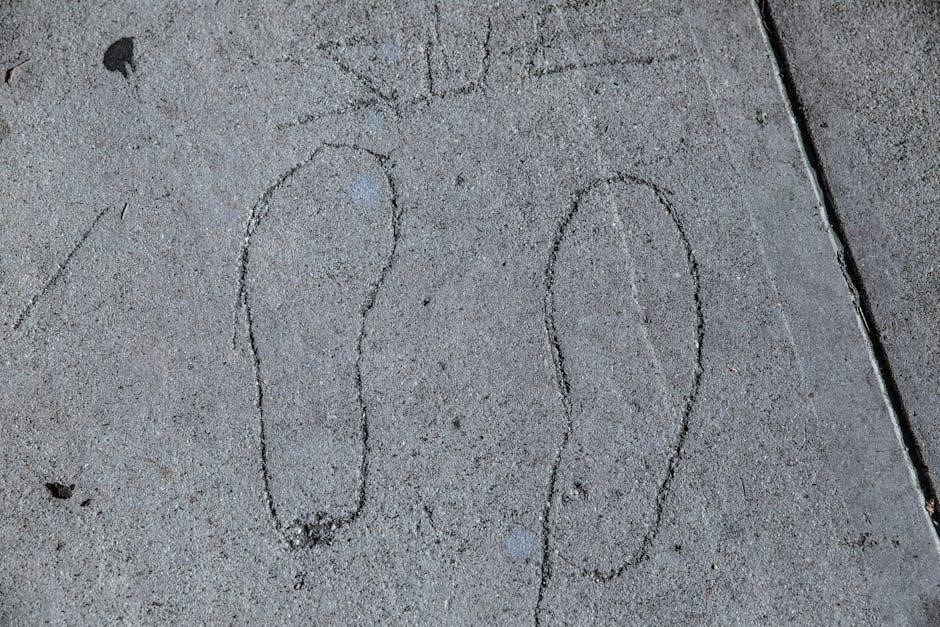This document explores the divine purpose and structured process of creation, highlighting God’s deliberate actions through His word and the inherent goodness of His work.
1.1. Overview of the Document
“La Creación de Dios PDF” is a comprehensive resource that outlines the biblical account of creation, emphasizing God’s deliberate and purposeful act of creating the universe. The document covers the seven days of creation, highlighting the divine order and the goodness of God’s work. It also includes practical activities, such as crafting scenarios and downloadable PDF templates, designed to engage children in understanding the creation story. The document underscores the theological significance of God as the sovereign Creator and the role of humanity as stewards of the Earth. It serves as both an educational and spiritual tool, encouraging reflection on God’s benevolence and the beauty of His creation.
1.2. Historical Context of the Creation Narrative

The creation narrative in “La Creación de Dios PDF” is rooted in the biblical account found in the book of Genesis, which has been a cornerstone of Judeo-Christian theology for centuries. The document highlights the historical significance of God’s deliberate and purposeful act of creation, emphasizing the divine order and structure of the universe. It underscores the theological importance of God as the sovereign Creator and the foundation of all existence. The narrative has been interpreted and shared across generations, shaping religious beliefs and cultural understanding. The document also provides historical insights into the interpretation of Genesis, offering a timeless message about God’s sovereignty and benevolence.
1.3. Purpose and Significance of the Document
The purpose of “La Creación de Dios PDF” is to explore the theological and spiritual dimensions of the creation narrative, offering insights into God’s nature and humanity’s role in the world. The document serves as a resource for faith formation, personal reflection, and communal discussion. Its significance lies in its ability to deepen understanding of the creation story, fostering a sense of awe and gratitude for God’s work. It also emphasizes the importance of stewardship and care for the earth, encouraging readers to live responsibly. By examining the creation narrative, the document provides a foundation for exploring themes of purpose, identity, and the divine plan, making it a valuable tool for spiritual growth and theological study.

Key Themes in the Creation Story
The creation story emphasizes divine purpose, the power of God’s word, and humanity’s role as stewards, highlighting the goodness and order of creation.
2.1. The Divine Purpose of Creation
The divine purpose of creation is central to the narrative, reflecting God’s intentional and orderly plan. It emphasizes that creation is not random but serves a greater design. The story highlights God’s desire to establish a world filled with life, order, and harmony. This purpose is evident in the separation of light and darkness, the creation of habitats for living beings, and the formation of humanity in God’s image. The narrative underscores that everything was created to glorify God and fulfill His will, with humanity entrusted to steward the earth responsibly. This theme reinforces the idea that creation is meaningful and purposeful, shaped by God’s wisdom and love.
2.2. The Power of God’s Word in Creation
The creation narrative underscores the profound power of God’s Word as the primary instrument of creation. Through spoken commands, God brings order and life into existence. The repeated phrase “And God said” highlights the authority and efficacy of His speech. Each creative act is initiated by God’s Word, demonstrating its limitless power. This theme emphasizes that God’s Word is not merely a communication but a creative force. The precision and simplicity of God’s commands reflect His sovereignty and wisdom. The account illustrates that God’s Word is both the source and sustainer of all creation, reinforcing the theological concept of divine speech as the foundation of existence. This idea is central to understanding the nature of God’s power and creativity.
2.3. The Goodness of God’s Creation
The creation narrative repeatedly emphasizes the inherent goodness of God’s creation. After each day, God observes the created works and declares them “good.” This affirmation underscores the perfection and harmony of His creative acts. The creation of humanity as the pinnacle of God’s work is particularly noted as “very good,” highlighting the special status of human beings. The goodness of creation reflects God’s character and intention for the world to be a place of beauty, order, and life. This theme encourages readers to appreciate the value and purpose of all created things, fostering a sense of wonder and gratitude for the world God has made. The narrative also implies humanity’s responsibility to preserve and honor this goodness.

The Seven Days of Creation
The creation narrative unfolds systematically over seven days, detailing God’s methodical and purposeful acts. Each day builds upon the previous, culminating in the creation of humanity and a day of rest, symbolizing completion and sanctification. This structure emphasizes order, progression, and divine intention, showcasing God’s sovereignty and the intrinsic value of creation. The seven days provide a theological framework for understanding the origin of the world and humanity’s place within it, blending both poetic and symbolic elements to convey profound truths about existence and purpose. The narrative’s rhythmic pattern reinforces its sacred and universal significance.
3.1. Day 1: The Creation of Light and Darkness
On the first day, God separated light from darkness, establishing the foundational rhythm of creation. This act, recorded in Genesis 1:3-5, demonstrates God’s divine command and the immediate response of creation. The separation symbolizes the distinction between order and chaos, setting the stage for the structured unfolding of creation. The creation of light emphasizes God’s sovereignty and purposeful design. This day laid the groundwork for the subsequent days, showcasing God’s methodical and intentional creativity. The separation of light and darkness also foreshadows theological themes of good and evil, highlighting the divine order imposed on the world. This initial act underscores the power of God’s word and the beginning of cosmic harmony.
Genesis 1:3-5
3.2. Day 2: The Creation of the Sky and the Separation of Waters
On the second day, God created the sky, or firmament, to separate the waters above from the waters below (Genesis 1:6-8). This act of separation brought order and structure to the chaotic waters, establishing a clear division between the heavenly and earthly realms. The sky not only provided a boundary but also created a space that would later support life. This day highlights God’s organizational wisdom and the progressive nature of creation. By separating the waters, God laid the foundation for the atmosphere and the eventual habitation of the earth. The firmament symbolizes God’s sovereignty and purposeful design, preparing the world for the upcoming days of creation.
Genesis 1:6-8
3.3. Day 3: The Creation of Land, Sea, and Vegetation
On the third day, God gathered the waters under the sky to form the seas and revealed the dry land (Genesis 1:9-10). This separation allowed the land to produce vegetation: plants, herbs, and fruit-bearing trees, each according to their kind. The earth was adorned with greenery, symbolizing life and fertility. God’s command brought forth diversity and abundance, setting the stage for sustenance and beauty. This day emphasizes God’s provision and the foundational role of creation in sustaining life. The establishment of land and vegetation marked a pivotal moment, preparing the earth for the creatures and humanity to come.
Genesis 1:9-13
3.4. Day 4: The Creation of the Sun, Moon, and Stars
On the fourth day, God created the sun, moon, and stars to separate day from night (Genesis 1:14-19). These celestial bodies serve as signs, seasons, and lights to govern the earth. The sun was made to rule the day, while the moon and stars illuminate the night. This day highlights God’s order and purpose in creation, providing structure and rhythm to life on earth. The establishment of the sun and moon underscores God’s provision for timekeeping and the natural cycles essential for life. This creation also reflects God’s majesty and wisdom in designing a universe with both functionality and beauty.
Genesis 1:14-19
3.5. Day 5: The Creation of Sea Creatures and Birds
On the fifth day, God filled the seas with abundant life, creating every kind of sea creature and blessing them to multiply (Genesis 1:20-21). He also created birds to fill the skies, commanding them to be fruitful and increase in number. This day emphasizes God’s creativity and provision, as He brought forth diverse aquatic and airborne life. The creation of these creatures showcases God’s power and care in populating the earth with vibrant and thriving ecosystems. The Bible highlights the beauty and variety of these creations, reflecting God’s delight in His work.
Genesis 1:20-21
3.6. Day 6: The Creation of Land Animals and Humanity
On the sixth day, God created land animals of every kind, each according to its own species (Genesis 1:24-25). He then formed humanity in His own image, creating male and female (Genesis 1:26-27). This day marks the pinnacle of creation, with humanity being endowed with dominion over the earth and its creatures; God blessed them, commanding them to be fruitful and multiply. The creation of humanity in God’s image highlights their unique role and responsibility as stewards of the earth. This day underscores God’s love and purpose for humanity, making them the crown of His creation.
Genesis 1:26-28
3.7. Day 7: The Day of Rest and Sanctification

On the seventh day, God rested from all His work of creation, sanctifying it as a day of rest for humanity (Genesis 2:3). This day signifies the completion of creation and establishes a pattern for humanity to observe rest. God blessed the seventh day, making it holy, as He ceased from His creative work. This rest is not due to fatigue but a divine act of completion and a gift to humanity. The seventh day serves as a reminder of God’s sovereignty and humanity’s need for rest and worship. It also foreshadows the Sabbath commandment given later in Exodus 20:8-11, emphasizing its enduring significance.
Genesis 2:3

The Role of Humanity in God’s Creation
Humanity, created in God’s image, holds a unique role as stewards of the earth, reflecting divine qualities and living in harmony with creation (Genesis 1:26-28).
Genesis 1:26-28
4.1. The Creation of Humanity in God’s Image
The creation of humanity in God’s image is a central theme in the biblical narrative, emphasizing human dignity and uniqueness. Genesis 1:26-27 describes humanity as created in the likeness of God, endowed with moral awareness, creativity, and the capacity for relationship. This divine image sets humans apart from other creatures, assigning them a unique role in the cosmos. The text highlights that both male and female are equally bearers of God’s image, reflecting divine diversity and equality. This theological concept underscores human value and responsibility, shaping ethical and relational dimensions of life.
Genesis 1:26-27
4.2. The Stewardship of the Earth
The concept of stewardship in “La Creación de Dios PDF” emphasizes humanity’s role as caretakers of the Earth. Genesis 1:28 highlights God’s command to “subdue” and “have dominion” over creation, but this mandate is often misunderstood. It is not a license for exploitation but a call to manage and preserve the Earth responsibly. Human stewardship reflects God’s trust in humanity to care for His creation, ensuring its sustainability for future generations. This responsibility includes wise use of resources, protection of biodiversity, and maintaining the balance of nature. It underscores the moral duty of humans to act as faithful managers of the world God created.
Genesis 1:28
4.3. Humanity as the Crown of God’s Creation
In “La Creación de Dios PDF,” humanity is portrayed as the pinnacle of God’s creation, uniquely made in His image (Genesis 1:26-27). This distinction grants humans a special role and dignity, setting them apart from other creatures. Being created in God’s likeness implies rational thought, moral capacity, and the ability to relate to the Creator. Humanity’s position as the “crown of creation” signifies a divine purpose, reflecting God’s love and wisdom. This status not only highlights human value but also underscores the responsibility to live according to God’s will. The creation narrative thus affirms that humans are central to God’s plan, embodying His glory and care for the world.
Genesis 1:26-27

The Concept of God as Creator
God as Creator embodies omnipotence and wisdom, forming the universe through His Word to bring glory to Himself and establish life with purpose.
Psalm 19:1
5.1. God’s Sovereignty in Creation
God’s sovereignty in creation underscores His absolute authority and control over all existence. As the omnipotent Creator, He brought the universe into being by His Word, demonstrating unmatched power and wisdom. This sovereignty is evident in the precise order and complexity of creation, reflecting His divine nature. God’s decisions in creation are unfettered by external influences, showcasing His freedom and supremacy. The creation narrative highlights His right to shape reality according to His will, establishing a cosmic order that glorifies Him. This divine sovereignty not only underscores God’s majesty but also provides a foundation for humanity’s understanding of His governance over all things.
Psalm 93:1
5.2. God’s Benevolence and Providence
God’s benevolence and providence are central to the creation narrative, showcasing His kindness and care for all He created. Through His benevolence, God provided abundance and sustenance, ensuring the well-being of His creation. His providence is evident in the intricate design and balance of the universe, demonstrating His ongoing involvement in sustaining life. From the creation of humanity to the provision of resources, God’s goodness and foresight are undeniable. This benevolence extends to humanity, whom He created in His image, granting them dominion and care over the earth. The creation story highlights God’s loving nature and His desire for a harmonious relationship with His creation.
Psalm 145:9
5.3. The Trinity and the Creation Narrative
The creation narrative in “La Creación de Dios PDF” reflects the involvement of the Trinity—Father, Son, and Holy Spirit—in the act of creation. The Father is often seen as the initiator and sustainer, while the Son, as the Word of God, is the agent through whom creation occurs (John 1:1-3). The Holy Spirit is described as the one who hovered over the waters, bringing life and order to the chaos (Genesis 1:2). This Trinitarian collaboration underscores the unity and diversity within the Godhead. The creation story thus reveals the Trinity’s shared purpose and harmony in bringing forth the universe, emphasizing the divine nature of creation and humanity’s role within it.

Psalm 104:24

Lessons and Reflections from the Creation Story
The creation story offers profound insights into gratitude, stewardship, and the divine order of life. It reminds humanity of its responsibility to care for creation and appreciate its beauty.
Genesis 1:31
6.1. Gratitude for God’s Creation
The creation narrative inspires profound gratitude for God’s majestic work. Each element of creation, from the vastness of the heavens to the intricacy of life, reflects divine wisdom and love. The beauty of nature, the balance of ecosystems, and the gift of humanity’s unique role in creation evoke appreciation and awe. Recognizing God as the Source of all life fosters a sense of thankfulness and humility. This gratitude is not just emotional but also relational, inviting believers to respond to God’s generosity with worship and obedience. The Psalmist’s declaration, “The earth is the Lord’s, and everything in it,” reminds us to cherish and honor God’s creation with heartfelt gratitude and stewardship.
Psalms 24:1
6.2. Human Responsibility Toward Nature
Humanity bears a sacred responsibility to care for and manage God’s creation. The biblical account assigns humans dominion over the earth, not for exploitation, but for stewardship. This involves preserving the balance of nature, protecting biodiversity, and ensuring sustainable use of resources. The creation story emphasizes humanity’s role as caretakers, entrusted with the duty to maintain the integrity of God’s work. Neglecting this responsibility leads to environmental degradation and harm to future generations. By embracing ethical practices and living sustainably, humanity honors God’s creation and fulfills its divine mandate to protect the earth.
Genesis 1:28
6.3. The Beauty and Order of Creation
The creation narrative reveals the intrinsic beauty and order of God’s work. Each element, from light and darkness to land, sea, and living creatures, reflects a divine design. The separation of day and night, the placement of the sun and moon, and the diversity of life showcase a masterpiece of harmony and precision. This order underscores God’s wisdom and artistry, inviting humanity to marvel at the complexity and beauty of the world. The creation story inspires awe and appreciation for the intricate balance of nature, reminding us of the Creator’s love and intentionality in crafting such a magnificent universe.
7.1. Summary of Key Points
The creation narrative in “La Creación de Dios PDF” highlights God’s sovereignty and purpose in forming the universe. It emphasizes the separation of light and darkness, land and sea, and the creation of celestial bodies to govern time. The document underscores humanity’s unique role as stewards of the earth, created in God’s image. It reflects on the beauty and order of creation, as well as the Trinity’s involvement in the narrative. Themes of gratitude, human responsibility, and the divine design of the world are central. The document encourages readers to appreciate the intricate details of God’s creation and their place within it, offering timeless lessons for faith and stewardship.
7.2. The Timeless Message of the Creation Story
The creation narrative in “La Creación de Dios PDF” carries a timeless message about God’s nature, humanity’s purpose, and the world’s order. It emphasizes the balance of nature, the dignity of human life, and the divine intention behind creation. The story encourages gratitude for the world’s beauty and fosters a sense of responsibility to preserve it. Its universal themes transcend time, offering insights into faith, stewardship, and the relationship between Creator and creation. The narrative remains relevant today, inspiring reflection on humanity’s role within the larger cosmic design and the enduring truth of God’s love and wisdom in forming the universe.

Resources for Further Study
- Recommended Reading: Explore books like “Genesis” by Juan Luis Ruiz de la Peña and “La Creación” by Jorge Viñuela for deeper insights.
- Bible Verses: Reflect on Genesis 1-2, Psalm 19, and Romans 1:20 for biblical perspectives on creation.
8.1. Recommended Reading and References
For a deeper understanding of “La Creación de Dios PDF,” explore these resources:
- Genesis: A Commentary by Gerhard von Rad offers theological insights into the creation narrative.
- The Creation of the World by John Stek provides a detailed exegesis of Genesis 1-2.
- La Creación en la Biblia by Jorge Viñuela explores the biblical account in Spanish.
- Creation and the Sovereignty of God by Hugh J. McCann discusses God’s role as Creator;
- Visit Biblica for downloadable study guides on Genesis.
These works enrich the study of creation theology and its significance.
8.2. Bible Verses for Reflection and Study
The creation narrative in La Creación de Dios PDF is deeply rooted in Scripture. Key verses include:
- Genesis 1:1: “In the beginning, God created the heavens and the earth.” This verse establishes God as the Creator of all.
- Genesis 1:3: “And God said, ‘Let there be light,’ and there was light.” Highlights the power of God’s word.
- Genesis 1:27: “So God created mankind in his own image.” Emphasizes humanity’s unique status.
- Genesis 2:2-3: Describes the seventh day as a day of rest, sanctified by God.
- Psalm 19:1: “The heavens declare the glory of God.” Reflects on creation’s testimony to God’s majesty.
These verses provide a biblical foundation for studying the creation story. Visit Bible Gateway for further exploration.

